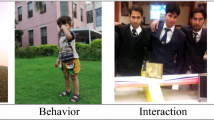Abstract
Gait has been recently proposed as a biometric feature that, with respect to other human characteristics, can be captured at a distance without requiring the collaboration of the observed subject. Therefore, it turns out to be a promising approach for people identification in several scenarios, e.g. access control and forensic applications. In this paper, we propose an automatic gait recognition system based on a set of features acquired using the 3D skeletal tracking provided by the popular Kinect sensor. Gait features are defined in terms of distances between selected sets of joints and their vertical and lateral sway with respect to walking direction. Moreover we do not rely on any geometrical assumptions on the position of the sensor. The effectiveness of the defined gait features is shown in the case of person identification based on supervised classification, using the principal component analysis and the support vector machine. A rich set of experiments is provided in two scenarios: a controlled identification setup and a classical video-surveillance setting, respectively. Moreover, we investigate if gait can be considered invariant over time for an individual, at least in a time interval of few years, by comparing gait samples of several subjects three years apart. Our experimental analysis shows that the proposed method is robust to acquisition settings and achieves very competitive identification accuracy with respect to the state of the art.












Similar content being viewed by others
References
Ahmed F, Paul PP, Gavrilova ML (2015) DTW-based kernel and rank-level fusion for 3D gait recognition using Kinect. Vis Comput 31(6–8):915–924
Allard P (1997) Three-dimensional analysis of human locomotion International Society Biomechanics series. Wiley, New York
Andersson V, Araujo R (2015). In: Proceedings of the twenty-ninth association for the advancement of artificial intelligence conference, AAAI
Ashbourn J (2002) Biometrics - advanced identity verification: the complete guide. Springer, Berlin
Bolle R, Pankanti S (1998) Biometrics, Personal Identification in Networked Society: Personal Identification in Networked Society. Kluwer Academic Publishers, Norwell
Bouchrika I, Nixon M (2007) In: Computer vision/computer graphics collaboration techniques. Springer, pp 150–160
Bouchrika I, Goffredo M, Carter J, Nixon M (2011) J Forensic Sci 56(4):882
Boyd JE, Little JJ (2005) . In: Advanced Studies in Biometrics. Springer, pp 19–42
Chattopadhyay P, Sural S, Mukherjee J (2014) IEEE Trans Inf Forensic Secur 9(11):1843
Chattopadhyay P, Sural S, Mukherjee J (2015) Pattern Recogn Lett 63:9
Connie T, Goh MKO, Teoh ABJ (2016) IEEE transactions on cybernetics
Cucchiara R, Grana C, Prati A, Vezzani R (2005) In: IEE Proceedings of Vision, Image and Signal Processing
Franc V, Hlavác V (2004) Czech: Center for Machine Perception, Czech Technical University, Prague
Gianaria E, Balossino N, Grangetto M, Lucenteforte M (2013) In: 2013 IEEE 15th international workshop on multimedia signal processing (MMSP), pp 440–445. https://doi.org/10.1109/MMSP.2013.6659329
Gianaria E, Grangetto M, Lucenteforte M, Balossino N (2014) In: Biometric authentication. Springer, pp 16–27
Gianaria E, Grangetto M, Balossino N (2017) In: International conference on image analysis and processing. Springer, pp 648–658
Goffredo M, Bouchrika I, Carter J, Nixon M (2010) Multimed Tools Appl 50(1):75. https://doi.org/10.1007/s11042-009-0378-5
Han J, Bhanu B (2006) IEEE Trans Pattern Anal Mach Intell 28(2):316
Hegeman J, Shapkova EY, Honegger F, Allum JH (2007) J Vestib Res 17(2):75
Jain AK, Ross A, Prabhakar S (2004) IEEE Trans Circ Syst Video Technol 14(1):4
Janssen LJ, Verhoeff LL, Horlings CG, Allum JH (2009) Gait Posture 29(4):575
Jung SU, Nixon M (2012) IEEE Trans Inf Forensic Secur 7(6):1802
Khoshelham K, Elberink SO (2012) Sensors 12(2):1437. https://doi.org/10.3390/s120201437
Khoshelham K, Elberink SO (2012) Sensors 12(2):1437
KinectUNITO gait dataset. http://www.di.unito.it/gianaria/~project_gait.html
Kusakunniran W (2014) IEEE Trans Inf Forensic Secur 9(9):1416
Larsen PK, Simonsen EB, Lynnerup N (2007) In: Proceedings of videometrics IX, vol 6491
Liao S, Jain AK, Li SZ (2013) IEEE Trans Pattern Anal Mach Intell 35(5):1193
Liu LF, Jia W, Zhu YH (2009) In: Huang DS, Jo KH, Lee HH, Kang HJ, Bevilacqua V (eds) Emerging intelligent computing technology and applications. With Aspects of Artificial Intelligence, Lecture Notes in Computer Science, vol 5755. Springer Berlin Heidelberg, pp 652–659. https://doi.org/10.1007/978-3-642-04020-7_70
Livingston MA, Sebastian J, Ai Z, Decker JW (2012) 2012 IEEE Virtual Reality (VR) 298(0704):119. https://doi.org/10.1109/VR.2012.6180911
Muramatsu D, Makihara Y, Yagi Y (2016) IEEE Trans Cybern 46(7):1602
Pala F, Satta R, Fumera G, Roli F (2015) IEEE Trans Circ Syst Video Technol 8215(MARCH):1. https://doi.org/10.1109/TCSVT.2015.2424056
Preis J, Kessel M, Werner M, Linnhoff-Popien C (2012). In: Proceedings of the first workshop on Kinect in pervasive computing
Sarkar S, Phillips PJ, Liu Z, Vega IR, Grother P, Bowyer KW (2005) IEEE Trans Pattern Anal Mach Intell 27(2):162. https://doi.org/10.1109/TPAMI.2005.39
Satta R, Pala F, Fumera G, Roli F (2013) In: 8th international conference on computer vision theory and applications (VISAPP 2013), Barcelona
Schölkopf B, Burges CJ (1999) Advances in kernel methods: support vector learning. MIT Press, Cambridge
Tafazzoli F, Safabakhsh R (2010) Eng Appl Artif Intell 23(8):1237
Urtasun R, Fua P (2004) In: 2004 Proceedings sixth IEEE international conference on automatic face and gesture recognition. IEEE, pp 17–22
Wang L, Tan T, Ning H, Hu W (2003) IEEE Trans Pattern Anal Mach Intell 25(12):1505
Wang J, She M, Nahavandi S, Kouzani A (2010) In: 2010 international conference on digital image computing: techniques and applications (DICTA). IEEE, pp 320–327
Yang K, Dou Y, Lv S, Zhang F, Lv Q (2016) Journal of Visual Communication and Image Representation
Zhang Z (2012) MultiMed IEEE 19(2):4
Zhang Y, Pan G, Jia K, Lu M, Wang Y, Wu Z (2015) IEEE Trans Cybern 45(9):1864
Author information
Authors and Affiliations
Corresponding author
Additional information
Publisher’s Note
Springer Nature remains neutral with regard to jurisdictional claims in published maps and institutional affiliations.
Rights and permissions
About this article
Cite this article
Gianaria, E., Grangetto, M. Robust gait identification using Kinect dynamic skeleton data. Multimed Tools Appl 78, 13925–13948 (2019). https://doi.org/10.1007/s11042-018-6865-9
Received:
Revised:
Accepted:
Published:
Issue Date:
DOI: https://doi.org/10.1007/s11042-018-6865-9




